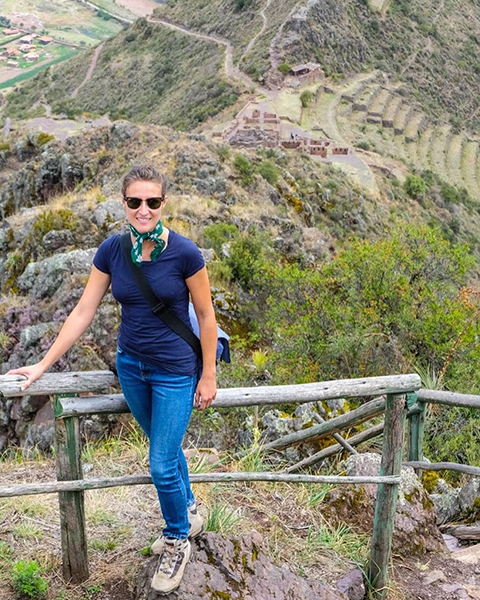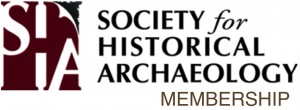Here’s the latest in our series of entertaining interviews with a diverse array of your fellow SHA members. Meet a member for the first time or learn something about a colleague that you never knew before. This blog series also offers current members an opportunity to share their thoughts on why SHA membership is important (Camaraderie? Professional service? Exchange of ideas in conference rooms and beyond? You tell us!). If you would like to be an interviewee, please email the Membership Committee Social Media Liaisons Eleanor Breen (eabreen@mountvernon.org) or Kim Pyszka (kmpyszka@aum.edu).
An Interview with Dr. April Huffman (aprilhuffman24@outlook.com), an independent archaeologist currently based in Boston, MA. April obtained her Ph.D. in Historical Archaeology from Harvard University and has spent the last decade immersed in the exploration and study of early American colonial sites. Her passion for uncovering the daily lives of early settlers and indigenous peoples has led her to numerous excavations across the northeastern United States. April’s dedication to public archaeology and community engagement has not only enriched her research but also helped to bring history to life for the general public. She is an active member of the Society for Historical Archaeology (SHA) and contributes significantly to the society’s outreach and educational initiatives.
Fieldwork or labwork?
For me, the thrill of fieldwork is unparalleled. There’s an element of adventure and unpredictability in every excavation—each dig is like a new chapter in a historical novel waiting to be discovered. The physical act of uncovering artifacts, standing where people once lived, and seeing history come alive beneath your hands is an experience that’s hard to match. Each layer of soil you remove can reveal something new and exciting, providing a tangible connection to the past. That said, I also cherish the systematic and reflective nature of labwork, where every artifact is meticulously analyzed to piece together the broader narrative. Labwork allows for a deeper understanding of the findings, enabling us to analyze materials, date artifacts, and understand their contexts within the larger framework of human history. The quiet, detailed work in the lab is where theories are tested and the stories of the past are fully articulated. However, if I had to choose, the excitement of uncovering history in the field wins hands down, as it combines both the thrill of discovery and the foundational work for future analysis.
What would be your dream site to work at?
One of my dream sites to work at is the ancient city of Çatalhöyük in Turkey. This Neolithic site is one of the oldest known urban centers, dating back to around 7500 BC. The settlement provides fascinating insights into early human society, architecture, and daily life. The intricately built houses, decorated with murals and artifacts, offer a glimpse into the complex social structures and cultural practices of its inhabitants. The opportunity to study such an early and influential community would be incredibly enriching.
Another site that captivates my imagination is the Island of Saint-Louis in Senegal. As a UNESCO World Heritage site, Saint-Louis was an important colonial city and trading post, rich in history and cultural exchanges. The island’s unique blend of European and African influences provides a rich tapestry for archaeological exploration, shedding light on the interactions and transformations that occurred during the colonial period. Both sites are less known but offer incredible opportunities to uncover new and significant aspects of our past.
What are you currently reading?
I’m currently engrossed in “Sapiens: A Brief History of Humankind” by Yuval Noah Harari. It’s a compelling read that explores the history of our species from the Stone Age to the present. Harari’s ability to weave together history, science, and philosophy offers a profound understanding of human evolution and societal development. The book challenges many conventional narratives and encourages readers to think critically about the forces that have shaped human history.
Another book on my reading list is “The Dawn of Everything: A New History of Humanity” by David Graeber and David Wengrow. This book presents a radical new understanding of human history, arguing that early societies were far more complex and diverse than traditionally thought. It’s an inspiring read that pushes the boundaries of our understanding and opens up new avenues for research. Find “Sapiens” here and find “The Dawn of Everything” here.
What has been the most rewarding aspect of your career as an archaeologist, and what are your aspirations for the future?
The most rewarding aspect of my career has been the opportunity to engage with the public and share the wonders of archaeology with a broader audience. Witnessing people’s reactions when they learn about the tangible remnants of our past is incredibly fulfilling. There’s a unique joy in seeing someone’s eyes light up when they hold an artifact or hear a story about the people who used it centuries ago. Public archaeology allows us to make history accessible and relevant, fostering a deeper appreciation for our shared heritage.
Looking to the future, I aspire to expand my research on colonial and indigenous interactions in early America. I believe there is still much to learn about the complex relationships and cultural exchanges that shaped early American history. I also hope to continue developing educational programs that make archaeology accessible and exciting for all ages. By creating interactive experiences, workshops, and lectures, I aim to inspire the next generation of archaeologists and foster a love for history and discovery. Ultimately, my goal is to make meaningful contributions to our understanding of the past and help bridge the gap between ancient civilizations and our modern world.
How does your involvement with the SHA enhance your research and professional development in the field?
Being a part of the SHA has been crucial for my professional growth. The society offers a wealth of resources, including access to the latest research through its journal and conferences that provide platforms for sharing and discussing new ideas. The SHA journal, in particular, is an invaluable resource that keeps me informed about the latest discoveries, methodologies, and theoretical advancements in the field. The collaborative environment of SHA allows me to connect with fellow archaeologists, exchange insights, and stay updated on cutting-edge methodologies. Conferences and workshops organized by SHA provide opportunities to present my research, receive constructive feedback, and engage in stimulating discussions with colleagues. These interactions not only broaden my horizons but also foster collaborations and partnerships that enrich my research endeavors.
Moreover, the SHA’s commitment to public outreach aligns perfectly with my own goals, enabling me to participate in initiatives that promote archaeology to a wider audience. By serving on committees, peer-reviewing articles, and volunteering at events, I contribute to the advancement of the field while also enhancing my professional skills. These experiences have been invaluable in shaping my career and expanding my impact within the field.
What did you want to be when you grew up?
Growing up in Indiana, I was always outdoorsy, exploring the local woods and getting curious about Native American history. That naturally led me to dream about becoming an archaeologist. High school archaeology classes sealed the deal, and here I am, living the dream.
At what point in your career did you first join the SHA?
I joined SHA shortly after completing my Ph.D. in 2010. I was drawn to the society’s strong focus on historical archaeology and its supportive community. Joining SHA was a strategic decision that provided me with access to a wealth of resources and networking opportunities. The society’s conferences, publications, and workshops have been instrumental in advancing my research and professional development. Being part of SHA has provided me with numerous opportunities for collaboration and professional development. The society’s commitment to fostering a vibrant and inclusive archaeological community has allowed me to connect with experts in the field, share my research, and gain valuable insights from colleagues. Over the years, SHA has become an integral part of my professional journey, supporting my growth and helping me navigate the challenges and opportunities in the field of archaeology.
What advice would you give to individuals who are considering a career in archaeology or want to become involved in historical preservation efforts?
My advice would be to cultivate a genuine curiosity and passion for history and archaeology. Start by volunteering at local excavations or historical sites to gain hands-on experience. Practical experience is invaluable and will give you a real sense of what the work involves. Take advantage of educational resources and courses to build a solid foundation in the field. Understanding the theoretical and methodological aspects of archaeology is essential for conducting meaningful research.
Networking is also crucial—attend conferences, join professional organizations like SHA, and connect with experienced archaeologists. Building relationships within the archaeological community can open doors to opportunities, mentorship, and collaboration. Don’t be afraid to reach out to professionals and ask for advice or guidance.
Lastly, be patient and persistent. The field of archaeology requires dedication and resilience, but the rewards of uncovering our past and contributing to its preservation are well worth the effort. Embrace challenges, stay curious, and remain adaptable. Archaeology is a constantly evolving field, and being open to new ideas and approaches will serve you well in your career. By following these steps, you can build a fulfilling career in archaeology and make meaningful contributions to the preservation of cultural heritage.


